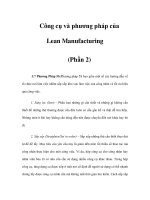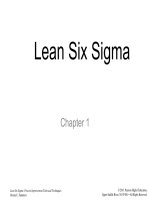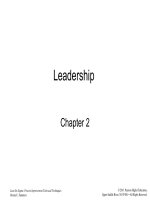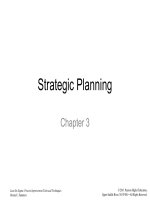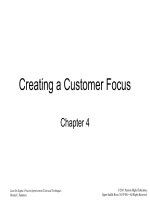Lean manufaturing 32 essential Lean Tools
Bạn đang xem bản rút gọn của tài liệu. Xem và tải ngay bản đầy đủ của tài liệu tại đây (904.53 KB, 33 trang )
LEAN
MANUFACTURING
32 essential Lean Tools
SWIPE
1
5S
5S is a simple but effective way to eliminate
waste and improve efficiency in the
workplace.
Create a safe, organized, and productive
work area through these 5 steps:
2
ABC inventory
It is a method of classifying inventory items
based on their importance. Items are
divided into three categories: A, B, and C.
3
Andon
Andon refers to a visual system that is used
to signal problems or defects in a
production process.
Andon systems can help to improve production
efficiency and quality
4
Bottleneck analysis
It is a method of identifying the steps in a
process that are limiting the overall output of
the process.
Bottlenecks can occur anywhere in a process,
from the initial planning stages to the final
product or service delivery.
5
Cellular
Manufacturing
It is a manufacturing strategy that groups
similar machines and processes together
into cells.
This allows for the efficient production of
similar products or families of products.
6
Continuous Flow
Continuous flow manufacturing (CFM) is a
manufacturing strategy that produces
products in a continuous and
uninterrupted flow.
This is in contrast to traditional
manufacturing methods, which often
involve batch production.
7
ERP
8
Gemba
Gemba refers to the actual place where work is
performed. This can be the factory floor, the
warehouse, or any other location where value
is created.
Goal: Gemba walks is to understand the actual
state of the workplace. This is done by
observing the work being done, talking to the
people who are working, & asking questions.
9
Heijunka
Heijunka refers to the practice of levelling
production so that it is more uniform &
predictable.
Looking for ways to reduce waste?
Heijunka is a good place to start improving
efficiency, and increasing predictability
10
Hoshin Kanri
Hoshin Kanri ensure that all levels of an
organization are working towards the same
goals.
A great way to increase alignment, focus,
efficiency, decision-making, and innovation
within your organization
11
Ishikawa
It is a visual tool that can be used to identify the
root causes of a problem.
The main problem statement is then broken
down into smaller problems, which are written on
the "bones" of the fish. These smaller problems
can then be broken down further into even
smaller problems.
12
Jidoka
This lean manufacturing principle aims to create
a system where machines can stop themselves if
they are not working properly.
This allows for the quick identification and
correction of problems, which can help to
improve quality, productivity, costs & safety.
13
Just-in-time (JIT)
It aims to deliver the right part at the right
time in the right quantity to the right place.
JIT is a powerful lean manufacturing principle
that can help to improve quality, productivity,
and costs.
14
Kaizen
It is a philosophy of continuous improvement
that can be applied to all aspects of life, including
manufacturing, business, and personal life.
The goal is to make small, incremental
improvements on a regular basis which leads to
significant improvements over time
15
Kanban
It is a visual management system that helps
teams visualize their work, identify bottlenecks,
and improve efficiency.
It is a pull system, which means that work is only
pulled into production when it is needed.
This helps to prevent overproduction and waste.
16
KPI's
They are used to measure the performance of a
manufacturing organization
Help to track progress towards goals
Helps identify areas for improvement
Helps to allocate resources effectively
Help to improve communication and
collaboration
Helps to improve communication and
collaboration
Most common KPIs include:
1. OEE
2. Machine Utilization
3. WIP
4. Lead time
5. Defect Rate
6. Customer satisfaction
17
Level Loading
A manufacturing technique that aims to
equalize the workload of a production line by
producing a steady stream of products at a
consistent rate.
This can help to reduce waste, improve
efficiency, and increase customer satisfaction.
Some of the benefits of using level loading:
Reduced waste
Improved efficiency
Reduced costs
Improved customer satisfaction
18
Mind Maps
A technique that uses a visual diagram to
organize and represent information related to a
manufacturing process.
It can be used to track the progress of a
manufacturing process, identify potential
problems, and brainstorm new ideas for
improving efficiency or quality.
19
Muda (Waste)
Muda refers to any activity that does not add
value to a product or service.
Muda can be found in all aspects of
manufacturing, from product design to
production to distribution.
20
Overall Equipment
Effectiveness
It is a measure of how well a manufacturing
plant is using its equipment.
OEE is calculated by multiplying three metrics:
availability, performance, and quality.
OEE = (Good Count × Ideal Cycle Time) / Planned
Production Time
21
PDCA (Plan, Do,
Check, Act)
PDCA is a four-step process for continuous
improvement & is used in a variety of fields,
including manufacturing, business, & education.
22
Poka-Yoke (Error
Proofing)
Poka-Yoke is a system of preventing mistakes or
defects in manufacturing processes.
It can be used to prevent a wide variety of
mistakes, including:
Using the wrong parts
Incorrect assembly
Wrong measurements
Damaged products
23
Root Cause Analysis
Root cause analysis (RCA) is a process of
identifying the underlying factors that
contributed to an event or problem
By identifying and eliminating the root causes of
problems, RCA can help to improve quality,
reduce costs, improve safety, and increase
customer satisfaction.
24
Single Minute
Exchange of Die
It is a manufacturing methodology that aims to
reduce the time it takes to change a die in a
manufacturing process.
The goal of SMED is to reduce the changeover
time to less than 10 minutes.

